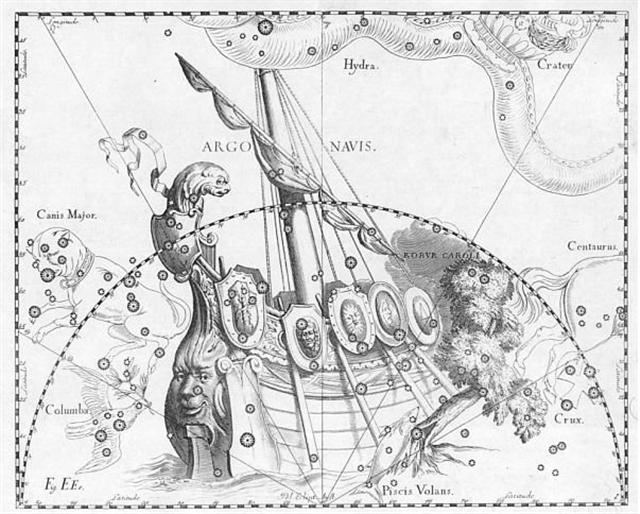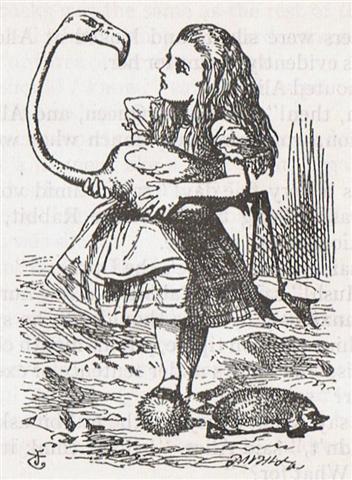6. Toliman (α Centauri) is no Tahitian star pillar but anyhow entered into our consciousnesses at Ana-mua, where the mysterious stern of Argo was presented between the hind quarters of Canis Major and Centaurus:
... The Ship appears to have no bow ... Aratos wrote: Sternforward Argō by the Great Dog's tail // Is drawn; for hers is not a usual course, // But backward turned she comes, as vessels do // When sailors have transposed the crooked stern // On entering harbour; all the ship reverse, // And gliding backward on the beach it grounds. // Sternforward thus is Jason's Argō drawn ... Argo is very low down we can see from Hydra, the water serpent, positioned above. Toliman corresponds to the Mad Dog in the Babylonian zodiac, where it stands at autumn equinox. In G we have the star at day number 222:
Why are there several ostriches, plural, in the Arabic Al Thalimain? Easy to answer: "The cock performs with his wings, alternating wing beats, until he attracts a mate. They will go to the mating area and he will maintain privacy by driving away all intruders. They graze until their behaviour is synchronized, then the feeding becomes secondary and the process takes on a ritualistic appearance. The cock will then excitedly flap alternate wings again, and start poking on the ground with his bill. He will then violently flap his wings to symbolically clear out a nest in the soil. Then, while the hen runs a circle around him with lowered wings, he will wind his head in a spiral motion. She will drop to the ground and he will mount for copulation. Ostriches reared entirely by humans may not direct their courtship behaviour at other Ostriches, but toward their human keepers. ... The females will lay their fertilized eggs in a single communal nest, a simple pit, 30 to 60 centimetres (12–24 in) deep and 3 metres (9.8 ft) wide, scraped in the ground by the male. The dominant female lays her eggs first, and when it is time to cover them for incubation she discards extra eggs from the weaker females, leaving about 20 in most cases ..." (Wikipedia) Although Hydra above Argo implicates the ship is a wreck at the bottom of the sea, the dog and centaur are land animals. The 'water' region in the sky is localized in extension. Ostriches do not fly, they are moa and not manu, and they need land with grass to live on. I need to quote from Alice in Wonderland (the chapter The Queen's Croquet Ground):
"Alice thought she had never seen such a curious croquet ground in her life: it was all ridges and furrows: the croquet balls were live hedgehogs, and the mallets live flamingoes, and the soldiers had to double themselves up and stand on their hands and feet, to make the arches. The chief difficulty Alice found at first was in managing her flamingo: she succeeded in getting its body tucked away, comfortably enough, under her arm, with its legs hanging down, but generally, just as she had got its neck nicely straightened out, and was going to give the hedgehog a blow with its head, it would twist itself around and look up in her face, with such a puzzled expression that she could not help bursting out laughing; and, when she had got its head down, and was going to begin again, it was very provoking to find that the hedgehog had unrolled itself, and was in the act of crawling away: besides all this, there was generally a ridge or a furrow in the way wherever she wanted to send the hedgehog to, and, as the doubled-up soldiers were always getting up and walking off to other parts of the ground, Alice soon came to the conclusion that it was a very difficult game indeed." I was led to remember this part of Alice in Wonderland because the scene had stayed in my mind from the time (now many years ago) when I read it. I could feel, at that time, that the hedgehogs had to be the planets and that the arches through which they were to be put must represent key positions in the sky. The bird with a long neck (be it ostrich, swan, crane, stork, or whatever) is an archetype (in the sense of Jung), and when I read about Grus (the crane) in Allen I learnt the constellation had another name, viz. the Flamingo: "The alternative title for the stars of Grus, Phoenicopterus, the Flamingo, is now seldom, if ever, used, nor can I find any record of its inventor, or date of its adoption as a constellaton name. Chilmead's Treatise contains this referents to it: The Phoenicopter we may call the Bittour (the old English word for Bittern) ... The Spaniards call it Flamengo: and it is described with the wings spread abroad, and as it were striking with his bill at the South Fish, in that part where he boweth himself. This asterism consistith of 13 Starres: of which, that of the second magnitude in his head is called, the Phoenicopters Eye: and it hath two other Stars also of the same magnitude, one in his backe, and the other in his left wing. And those two which are in the middle of his necke, Paulus Merula in his first booke of his Cosmography, calleth his Collar or Chaine. The absence of our titles in the foregoing description would show that the Bittern, or Flamingo, was the popular English figuring and title in the early part of the 17th century." Lewis Carroll (Charles Dodgson) lived between 1832 and 1898 and he surely must have known the Bittern. |
|||||||||||||||||||||||||||||||||||||||||||||||||||||



